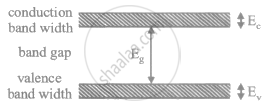Advertisements
Advertisements
Question
A semiconductor is doped with a donor impurity.
Options
The hole concentration increases.
The hole concentration decreases.
The electron concentration increases.
The electron concentration decreases.
Solution
The electron concentration increases.
When a semiconductor is doped with a donor type such as arsenic or phosphorous, which has five valence electrons, the donor atom replaces the Si or Ge atom. As a result, four out of the five electrons of the donor atom form a covalent bond by sharing an electron with four atoms of silicon. However, the fifth electron is free to move. Also, due to the breaking up of covalent bonds at room temperature, equal number of electrons and holes are produced. Thus, the total number of holes in the n-type semiconductor is less compared to the number of free electrons.
APPEARS IN
RELATED QUESTIONS
Draw the necessary energy band diagrams to distinguish between conductors, semiconductors and insulators.
How does the change in temperature affect the behaviour of these materials ? Explain briefly.
Distinguish between a metal and an insulator on the basis of energy band diagrams ?
The conduction band of a solid is partially filled at 0 K. Will it be a conductor, a semiconductor or an insulator?
When an electron goes from the valence band to the conduction band in silicon, its energy is increased by 1.1 eV. The average energy exchanged in a thermal collision is of the order of kT which is only 0.026 eV at room temperature. How is a thermal collision able to take some to the electrons from the valence band to the conduction band?
What is the resistance of an intrinsic semiconductor at 0 K?
Electric conduction in a semiconductor takes place due to
An electric field is applied to a semiconductor. Let the number of charge carries be nand the average drift speed by v. If the temperature is increased,
Let np and ne be the number of holes and conduction electrons in an intrinsic semiconductor.
When a semiconducting material is doped with an impurity, new acceptor levels are created. In a particular thermal collision, a valence electron receives an energy equal to 2kT and just reaches one of the acceptor levels. Assuming that the energy of the electron was at the top edge of the valence band and that the temperature T is equal to 300 K, find the energy of the acceptor levels above the valence band.
The band gap between the valence and the conduction bands in zinc oxide (ZnO) is 3.2 eV. Suppose an electron in the conduction band combines with a hole in the valence band and the excess energy is released in the form of electromagnetic radiation. Find the maximum wavelength that can be emitted in this process.
The conductivity of a pure semiconductor is roughly proportional to T3/2 e−ΔE/2kT where ΔE is the band gap. The band gap for germanium is 0.74 eV at 4 K and 0.67 eV at 300 K. By what factor does the conductivity of pure germanium increase as the temperature is raised from 4 K to 300 K?
The product of the hole concentration and the conduction electron concentration turns out to be independent of the amount of any impurity doped. The concentration of conduction electrons in germanium is 6 × 1019 per cubic metref conduction electrons increases to 2 × 1023 per cubic metre. Find the concentration of the holes in the doped germanium.. When some phosphorus impurity is doped into a germanium sample, the concentration o
Hydrogen atom in n = 3 state has a lifetime of 10-10 sec. The number of revolutions an electron makes in the n = 3 state before returning to the ground state is ______.
Useful data
`1/(4pi∈_0) = 8.99 xx 10^-34`N m2 C-2; e = 1.60 10-19 C; h = 6.63 10-34 Js; me = 9 × 10-3 kg
Two radioactive substances A and B have decay constants 3λ and λ respectively. At t = 0 they have the same number of nuclei. The ratio of the number of nuclei of A to those of B will be `1/"e"` after a time interval:
If the lattice constant of this semiconductor is decreased, then which of the following is correct?

The energy of a hydrogen atom in the ground state is −13.6 eV. The energy of a He+ ion in the first excited state will be:
A hole in a. p – type semiconductor is
The reaction between α and β parameter of a transistor is given by
Hole are majority charge carrier in
With reference to semiconductor physics, answer the following question.
What is meant by “Forbidden band" of energy levels?
